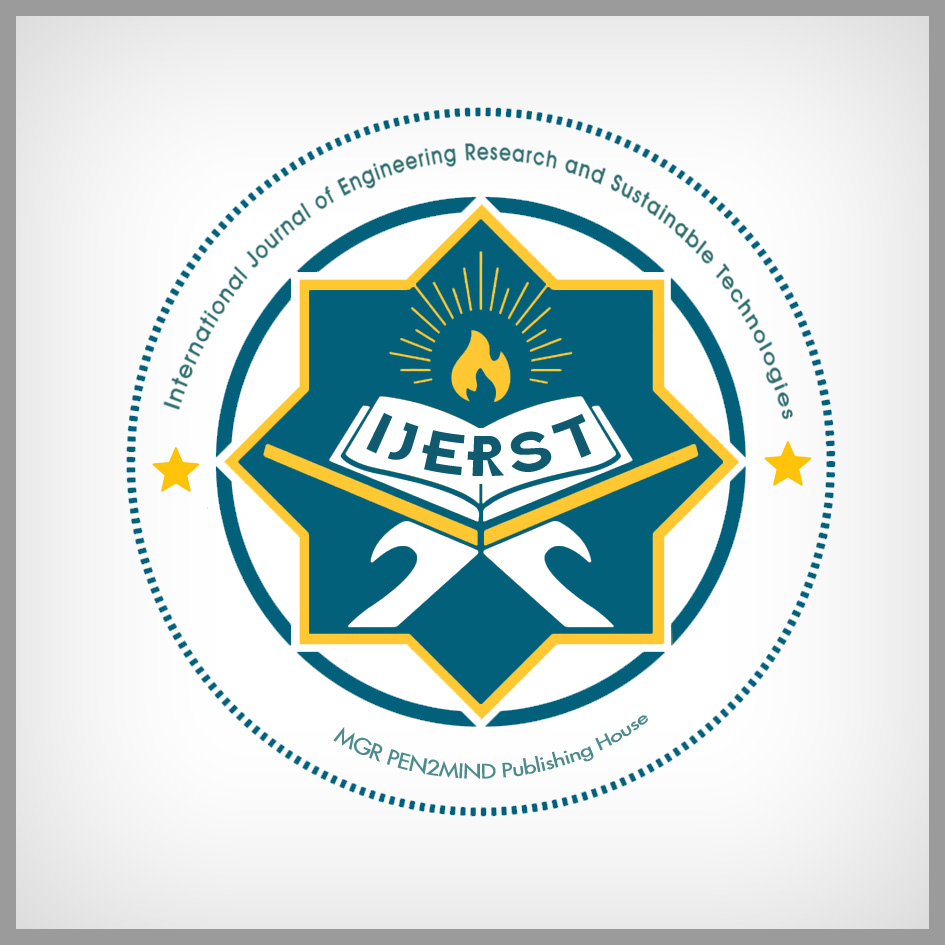BIOSYNTHESIZED GOLD NANOPARTICLES FROM RED SEAWEED AMPHIROA FRAGILISSIMA THROUGH ANTIOXIDANT AND ANTICANCER ACTIVITY AGAINST OSTEOSARCOMA CANCER CELLS
DOI:
https://doi.org/10.63458/ijerst.v2i2.79Keywords:
Gold nanoparticles, Amphiroa fragilissima, Osteosarcoma (MG-63), antioxidant, anti-inflammatory, anticancerAbstract
The goal of this Paper is to improve cybersecurity threat detection by thoroughly examining deep learning and machine learning
models. The study attempts to solve the difficulty of precisely categorizing and forecasting hostile actions in network traffic
by focusing on a dataset that encompasses a variety of cyber threats. Preprocessing the data, using Principal Component
Analysis (PCA) to apply dimensionality reduction, and putting a variety of machine learning algorithms into practice—
including Logistic Regression, K-Nearest Neighbours, Gaussian Naive Bayes, Support Vector Machines, Decision Trees, and
Random Forest—are all part of the methodology. Important conclusions highlight how ensemble models— Random Forest in
particular—work well to achieve notable precision and accuracy. Principal Component Analysis's effect on model performance
is also examined, providing information about the significance of features and the interpretability of the model. In addition to
highlighting the promise of ensemble methods for reliable threat detection, the research provides insightful information about
the efficacy of different machine learning algorithms in cybersecurity. The study’s insights have practical consequences for
cybersecurity practitioners and lay the groundwork for future cybersecurity analytics research projects.
References
Al Saqr, A., Khafagy, E.S., Alalaiwe, A., Aldawsari, M.F., Alshahrani, S.M., Anwer, M.K., Khan, S., Lila,
A.S.A., Arab, H.H. and Hegazy, W.A., “Synthesis of gold nanoparticles by using green machinery:
Characterization and in vitro toxicity. Nanomaterials, 11(3), p.808. 2021 DOI: https://doi.org/10.3390/nano11030808
Brown, J.S., Amend, S.R., Austin, R.H., Gatenby, R.A., Hammarlund, E.U. and Pienta, K.J., “Updating the definition of cancer. Molecular Cancer Research, 21(11), pp.1142-1147. 2023 DOI: https://doi.org/10.1158/1541-7786.MCR-23-0411
Ritter, J. and Bielack, S.S., “Osteosarcoma. Annals of oncology, 21, pp. vii320-vii325. 2010 DOI: https://doi.org/10.1093/annonc/mdq276
Gajanan, K. and Tijare, S.N., “Applications of nanomaterials. Materials Today: Proceedings, 5(1), pp.1093-1096. 2018 DOI: https://doi.org/10.1016/j.matpr.2017.11.187
Mohanraj, V.J. and Chen, Y.J.T.J.O.P.R., “Nanoparticles-a review. Tropical journal of pharmaceutical research, 5(1), pp.561-573. 2006 DOI: https://doi.org/10.4314/tjpr.v5i1.14634
Ponnuchamy, K. and Jacob, J.A., “Metal nanoparticles from marine seaweeds–a review. Nanotechnology
Reviews, 5(6), pp.589-600. 2016.
Pandimurugan, R. and Thambidurai, S., “Novel seaweed capped ZnO nanoparticles for effective dye photodegradation and antibacterial activity. Advanced Powder Technology, 27(4), pp.1062-1072. 2016, DOI: https://doi.org/10.1016/j.apt.2016.03.014
Viswanathan, S., Palaniyandi, T., Shanmugam, R., Rajendran, B.K. and Sivaji, A., “ Biomedical potential of silver nanoparticles capped with active ingredients of Hypnea valentiae, red algae species. Particulate Science and Technology, 40(6), pp.686-696 a. 2022. DOI: https://doi.org/10.1080/02726351.2021.1992059
Baskar, G., Palaniyandi, T., Viswanathan, S., Wahab, M.R.A., Surendran, H., Ravi, M., Rajendran, B.K.,
Govindasamy, G., Sivaji, A. and Kaliamoorthy, S., “Pharmacological effect of gold nanoparticles from red algae Halymenia venusta on A549 cell line. Inorganic Chemistry Communications, 155, p.111005. 2023. DOI: https://doi.org/10.1016/j.inoche.2023.111005
Baskar, G., Palaniyandi, T., Ravi, M., Viswanathan, S., Wahab, M.R.A., Surendran, H., Govindaraj, M.,
Sugumaran, A., Almutairi, M.H. and Almutairi, B.O., “Biosynthesis of iron oxide nanoparticles from red seaweed Hypnea valentiae and evaluation of their antioxidant and antitumor potential via the AKT/PI3K pathway. Process Biochemistry, 141, pp.155-169. 2024. DOI: https://doi.org/10.1016/j.procbio.2024.03.010
Gunathilake, K.D.P.P., Ranaweera, K.K.D.S. and Rupasinghe, H.V., “In vitro anti-inflammatory properties of selected green leafy vegetables. Biomedicines, 6(4), p.107. 2018. DOI: https://doi.org/10.3390/biomedicines6040107
Viswanathan, S., Palaniyandi, T., Chellam, D.C., Ahmed, M.F., Shoban, N., Pushpakumar, M., Wahab,
M.R.A., Baskar, G., Ravi, M., Sivaji, A. and Natarajan, S., “Anti-cancer activity of Hypnea valentiae seaweed loaded gold nanoparticles through EMT signaling pathway in A549 cells. Biochemical Systematics and Ecology, 107, p.104606. 2023. DOI: https://doi.org/10.1016/j.bse.2023.104606
Sanchez-Ramirez, J.F., Pal, U., Nolasco-Hernandez, L., Mendoza-Álvarez, J. and Pescador-Rojas, J.A., “Synthesis and Optical Properties of Au-Ag Alloy Nanoclusters with Controlled Composition. Journal of Nanomaterials.2008. DOI: https://doi.org/10.1155/2008/620412
Chellapandian, C., Ramkumar, B., Puja, P., Shanmuganathan, R., Pugazhendhi, A. and Kumar, P., “Gold nanoparticles using red seaweed Gracilaria verrucosa: Green synthesis, characterization and biocompatibility studies. Process Biochemistry, 80, pp.58-63.2019. DOI: https://doi.org/10.1016/j.procbio.2019.02.009
Singh, A.K., Tiwari, R., Singh, V.K., Singh, P., Khadim, S.R., Singh, U., Srivastava, V., Hasan, S.H. and
Asthana, R.K., “Green synthesis of gold nanoparticles from Dunaliella salina, its characterization and in vitro anticancer activity on breast cancer cell line. Journal of Drug Delivery Science and Technology, 51, pp.164-176 2019. DOI: https://doi.org/10.1016/j.jddst.2019.02.023
Gholami, M., Abbasi, N., Ghaneialvar, H., Karimi, E., Afzalinia, A., Zangeneh, M.M. and Yadollahi, M.,
“Investigation of biological effects of chitosan magnetic nano-composites hydrogel. Nanotechnology, 33(49), p.495603 2022. DOI: https://doi.org/10.1088/1361-6528/ac88da
Chen, J., Li, Y., Fang, G., Cao, Z., Shang, Y., Alfarraj, S., Alharbi, S.A., Li, J., Yang, S. and Duan, X.,
“Green synthesis, characterization, cytotoxicity, antioxidant, and anti-human ovarian cancer activities of Curcumae kwangsiensis leaf aqueous extract green-synthesized gold nanoparticles. Arabian Journal of Chemistry, 14(3), p.103000. 2021. DOI: https://doi.org/10.1016/j.arabjc.2021.103000
Palanisamy, S., Rajasekar, P., Vijayaprasath, G., Ravi, G., Manikandan, R. and Prabhu, N.M., “A green route to synthesis silver nanoparticles using Sargassum polycystum and its antioxidant and cytotoxic effects: an in vitro analysis. Materials Letters, 189, pp.196-200.2017. DOI: https://doi.org/10.1016/j.matlet.2016.12.005
Babu, B., Palanisamy, S., Vinosha, M., Anjali, R., Kumar, P., Pandi, B., Tabarsa, M., You, S. and Prabhu, N.M., “Bioengineered gold nanoparticles from marine seaweed Acanthophora spicifera for pharmaceutical uses: antioxidant, antibacterial, and anticancer activities. Bioprocess and biosystems engineering, 43, pp.2231-2242. 2020. DOI: https://doi.org/10.1007/s00449-020-02408-3
Badeggi, U.M., Ismail, E., Adeloye, A.O., Botha, S., Badmus, J.A., Marnewick, J.L., Cupido, C.N. and Hussein, A.A., “Green synthesis of gold nanoparticles capped with procyanidins from Leucosidea sericea as potential antidiabetic and antioxidant agents. Biomolecules, 10(3), p.452. 2020 DOI: https://doi.org/10.3390/biom10030452
Hatipoğlu, A., Baran, A., Keskin, C., Baran, M.F., Eftekhari, A., Omarova, S., Janas, D., Khalilov, R., Adican, M.T. and Kandemir, S.İ., “Green synthesis of silver nanoparticles based on the Raphanus sativus leaf aqueous extract and their toxicological/microbiological activities. Environmental Science and Pollution Research, pp.1-13.2023. DOI: https://doi.org/10.1007/s11356-023-26499-z
Rajput, S., Kumar, D. and Agrawal, V., “Green synthesis of silver nanoparticles using Indian Belladonna extract and their potential antioxidant, anti-inflammatory, anticancer and larvicidal activities. Plant cell reports, 39, pp.921-939. 2020. DOI: https://doi.org/10.1007/s00299-020-02539-7
Alangari, A., Alqahtani, M.S., Mateen, A., Kalam, M.A., Alshememry, A., Ali, R., Kazi, M., AlGhamdi, K.M. and Syed, R., “Retracted: Iron Oxide Nanoparticles: Preparation, Characterization, and Assessment of Antimicrobial and Anticancer Activity. Adsorption Science & Technology, 2022, p.1562051. 2022. DOI: https://doi.org/10.1155/2022/1562051
Algotiml, R., Gab-Alla, A., Seoudi, R., Abulreesh, H.H., Ahmad, I. and Elbanna, K., “Anticancer and antimicrobial activity of red sea seaweeds extracts-mediated gold nanoparticles. J Pure Appl Microbiol, 16(1), pp.207-225. 2022. DOI: https://doi.org/10.22207/JPAM.16.1.11
Aziz, E., Batool, R., Khan, M.U., Rauf, A., Akhtar, W., Heydari, M., Rehman, S., Shahzad, T., Malik, A.,Mosavat, S.H. and Plygun, S., “An overview on red algae bioactive compounds and their pharmaceutical applications. Journal of complementary and Integrative Medicine, 17(4), p.20190203. 2021 DOI: https://doi.org/10.1515/jcim-2019-0203
Rajeshkumar, S., Malarkodi, C., Al Farraj, D.A., Elshikh, M.S. and Roopan, S.M., “Employing sulphated polysaccharide (fucoidan) as medium for gold nanoparticles preparation and its anticancer study against HepG2 cell lines. Materials Today Communications, 26, p.101975. 2021. DOI: https://doi.org/10.1016/j.mtcomm.2020.101975
Tao, C., “Antimicrobial activity and toxicity of gold nanoparticles: Research progress, challenges and prospects. Letters in applied microbiology, 67(6), pp.537-543. 2018. DOI: https://doi.org/10.1111/lam.13082
Liu, Z., Gao, T., Yang, Y., Meng, F., Zhan, F., Jiang, Q. and Sun, X., “Anti-cancer activity of porphyran and carrageenan from red seaweeds. Molecules, 24(23), p.4286. 2019. DOI: https://doi.org/10.3390/molecules24234286
Downloads
Published
How to Cite
Issue
Section
ARK
License
License Statement
This work is licensed under a Creative Commons Attribution 4.0 International License (CC BY 4.0).
Authors retain copyright of their articles and grant International Journal of Engineering Research in Science and Technology (IJERST) the right of first publication.
This license permits unrestricted use, distribution, and reproduction in any medium, provided the original author and source are credited.
The journal encourages open access and supports the global exchange of knowledge.




